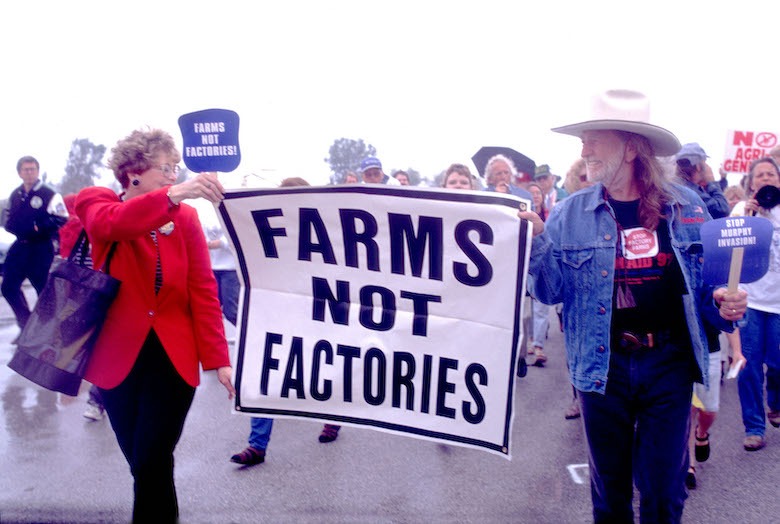How Rural Communities Are Fighting Farm Crisis-Fueled Xenophobia
There is a lot of bad news coming from farm country in 2019. Farm bankruptcies are up, due to five years of low farm prices, compounded by wet spring weather and the trade war with China. As in the rest of the US, anti-immigrant and white supremacist sentiment are also on the rise in many rural areas.
For many in rural America, 2019 feels like déjà vu. In the 1980s, a farm crisis swept through the heartland, shuttering over a quarter of a million farms. The decade saw a spike in rural anti-Semitism and other racism, as struggling farmers sought explanations for the crisis wherever they could.
There is a long history of rural white communities looking to racist ideology, especially in moments of crisis; blaming hardships on someone who doesn’t look like you can feel like an easy solution to your problems. At the same time there is also a long history of rural communities fighting back against these simplistic and hateful ideas, finding strength in unity rather than in division. Recently, Farm Aid, an organization that was founded in the heart of the 1980s farm crisis, convened meetings in Wisconsin highlighting how farmer organizers in the 1980s addressed racist extremism head on. They instead worked in broad multiracial coalitions to build power to end the farm crisis. The hopeful news is that similar work is happening around the countryside today.
The 1980s Farm Crisis
The 1980s farm crisis was caused by a perfect storm of politics and economics, including a Soviet grain embargo, skyrocketing interest and inflation rates, plummeting land values, and, crucially, changes pushed by agribusiness to farm programs that had previously insulated farmers from shocks. The crisis happened suddenly, as the fluctuations in interest rates and land values meant that many farmers’ net worth changed on paper when their actual circumstances had not changed at all. The causes were complex, but the impacts were easy to understand: farmers’ loans were suddenly called in, backed up by a foreclosure notice and an auction of their land and possessions when they could not pay. Families were forced off of land they had farmed for generations and left without a livelihood. The loss of farms rippled through the rural economy, as businesses that had relied on the economic engine of farming also closed down.
As white farmers in the Midwest were faced with this sudden and catastrophic loss, anti-Semitic and white nationalist groups saw an opportunity to build their ranks. Ideas that Jews controlled the government and similar racist beliefs began spreading through rural communities.
Reverend David Ostendorf, a United Church of Christ Minister, was a rural organizer in the 1980s. “Desperate people sometimes reach for desperate answers,” he told the advocates gathered in Wisconsin.
Organizing Against Both a Farm Crisis and Racism

The 1980s farm crisis was indeed a time of desperation, loss of farms, and rural collapse, but it was also fertile ground for creative organizing against racist ideologies. Ostendorf was part of a wave of grassroots organizers who built a strategy to both address people’s urgent needs and offer another explanation for the crisis. Their message was that corporate forces, including agribusiness, had caused the farm crisis with the elimination of farm programs that had protected farmers from major economic downturns. These same corporate forces were also impacting workers, cities, and people of color. Winning policy change to stop not just the farm crisis but also union-busting, disinvestment in cities, and other social problems was only possible by working together in broad-based coalitions that brooked the urban-rural divide.
Tactics like food pantries, farm crisis survival committees, and actions to stop farm auctions gave farm families the immediate help they needed. Once people were engaged (and had some immediate needs met), organizers held presentations to deconstruct racist ideologies and describe the real facts. They also invested in local leadership and developed alliances with a wide range of organizations, including Jewish and Christian religious leaders, organized labor, urban churches, and civil rights groups. Farmers developed a strong relationship with presidential candidate Jesse Jackson, whose campaign platform included a return to the farm programs that had protected farmers from crisis; engaged in mutual aid with the majority-black Federation of Southern Cooperatives; and got support for policy initiatives from the Congressional Black Caucus.
The farm movement’s strategy worked. By the end of the 1980s, as federal passage of the Agricultural Credit Act slowed the farm crisis, the rural hate groups had gone mostly quiet.
Organizing Through the 2019 Farm Crisis

Today, though the landscape has shifted in some significant ways – there are fewer farmers than there were 30 years ago, while corporate control has solidified over the farm sector – similar issues are again facing rural communities. A farm crisis is again forcing farmers off the land, driven by falling prices, a global trade war, and farm policy that still doesn’t shield them from shocks. Racist ideologies persist to explain the crisis, this time in the form of anti-immigrant sentiment and Islamophobia.
Mark Schultz, Executive Director of Minnesota-based Land Stewardship Project (LSP), suggests a path forward echoing the lessons of the 1980s farm movement. LSP is a member-led organization with a strong farming and rural base and a majority-white membership. Its programs focus on people’s immediate needs: stopping corporate-backed factory farms, workshops on soil health, building the local food system, fighting the current farm crisis.
LSP’s organizing strategy is explicitly antiracist, believing, as the 1980s farm movement did, that bankrupt family farmers are fighting against the same corporate-controlled system and for the same goals and rights as fast food workers, immigrants and refugees, and other minority groups. Winning is only possible through broad coalition. As one LSP publication states, “to fundamentally change the system, we’re going to need the grassroots participation of all kinds of people, regardless of race, or what country we were born in. Everyone in, no one left out.”
Organizing in Practice
Speaking to the advocates in Wisconsin, Schultz described what this looks like day to day: regular and ongoing racial equity trainings for LSP staff and member leaders; beginning hands-on workshops on subjects like soil health by discussing how racial justice relates to the topic; statements condemning blatant racism at the state and national level; active involvement in multiracial and multi-sectoral coalitions, and more.
“To fundamentally change the system, we’re going to need the grassroots participation of all kinds of people, regardless of race, or what country we were born in. Everyone in, no one left out.”
Investing in long-term, trusting relationships is key. LSP believes it will better accomplish its own aims by working alongside diverse organizations, whether the aims are as specific as increasing backing for a policy proposal or as general as building broader understanding of rural pressures. This means showing up to support partners when they need it. “When a target is put on the back of a population because of their race, religion, or where they’re from, we’re going to stand with them,” Schultz said, because LSP sees mutual benefit in working with these groups. “And if we don’t stand with them, why are they going to want to work with us?”
Hope Through Organizing
LSP isn’t the only rural organization taking this approach. While there’s a lot of bad news coming from farm country in 2019, there is also much hopeful organizing. David Ostendorf described his ongoing interfaith bridge-building with communities in Minnesota, while LSP partner organizations in Iowa and Missouri are bringing diverse communities together through clean water campaigns, farm camps, among other activities From Oregon to Kentucky, grassroots organizations are doing similar work.
Like in the 1980s, the factors causing today’s farm crisis are global and complex, which can lead people in crisis to turn against outsiders. Keeping rural communities together and moving forward through hard times is a challenge, but for more than thirty years, grassroots organizers have shown a way through uniting rather than dividing.
“The power to make the change we need is larger than us as an organization or us as a farm movement,” says Mark Schultz. “We need each other.”
More Reading
Do organic waste bans and composting programs really take a bite out of food waste?
March 17, 2025
What could massive cuts to SNAP benefits mean for the U.S. economy – and for all of us?
February 20, 2025
The EPA finally acknowledged the risks of PFAS in sewage sludge. What’s next?
February 10, 2025
How we came to rely on emergency food
September 30, 2024
Is flawed food policy responsible for listeria outbreaks in deli meats?
August 13, 2024
What does USDA’s new nutrition rule mean for school meals?
June 7, 2024
Limits for PFAS in drinking water signal a new phase in federal action on 'forever chemicals'
May 1, 2024
A new report envisions federal food spending as a force for good
January 3, 2024
It’s Been a Big Year for the Labor Movement. What About Farmworkers?
August 31, 2023
Escalating U.S.-Mexico Debate over Corn Forces Questions about GMOs, Food Sovereignty
June 5, 2023

